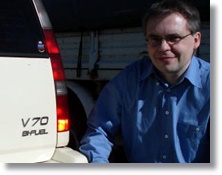

|
Ari Lampinen is associate professor of renewable
energy at Strömstad Academy, since March 2009. He worked at Department
of Physics of University of Jyväskylä as researcher in 1986-1988 and as
assistant professor (assistentti) in 1991-1996. He was visiting researcher
at Niels Bohr Institute at Risø in Denmark in 1986-1987 and at Stanford
University in the USA in 1991-1992. He was research associate (tutkimusassistentti)
at Academy of Finland in 1988-1991. All this work was in the fields of
experimental nuclear physics and computer science. He first became exposed to renewable energy
technologies while working in 1986-1987 at Risø, the location of the
largest wind energy research facility in the world. While working in
California in 1991-1992 he became further aware of many practical
renewable energy solutions to climate change and many other acute
environmental problems. He started teaching and development work in
those fields in 1994. He pursued those fields as associate professor (yliassistentti) of air pollution control technology
in 1998-2001 and associate professor of environmental physics in
2001-2006 at Department of Biological and Environmental Science of
University of Jyväskylä. Since 2006 he has worked at several
universities, companies and administration with various renewable energy
related consulting, research and training functions. He initiated and co-founded renewable energy education
network SOLIS (SOLar energy In Schools) of Finnish high schools, which
was started in 1997 as a project of Finnish Physical Society and
National Board of Education. He initiated and co-founded a
multidisciplinary Renewable Energy Education and Research Programme of
University of Jyväskylä, which started in 2003. His work has included
writing almost 500 publications and more than 200 expert
opinions/reviews/statements, supervising over 50 university theses,
giving over 100 lecture courses in several universities, giving over 300
invited presentations and attending numerous conferences and United
Nations negotiations. He has been involved in many renewable energy
projects of scientific, environmental, municipal, provincial,
governmental and intergovernmental organizations as well as companies,
both in developed and developing countries. His renewable energy work
started with solar energy and has later covered most renewable energy
technologies, not only from the point of view of natural sciences and
engineering, but also utilizing disciplines of sociology, political
science, economics, education and law. For the past several years his main focus has been in
renewable energy use in transport applications and non-technical
barriers of renewable energy utilization. |